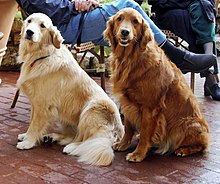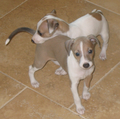Deer color
A beige hue is called deer in various pets. The English equivalent is fawn .
dog
Deer colored dogs can arise in different ways. They carry at least one allele a y of the agouti locus or the allele e of the extension locus twice ( homozygous ).
Allele a y of the agouti locus
The allele a y is dominant against the other three known agouti alleles a w (wild type), a t ( tan or black and tan or blue and tan ) and a (non-agouti, recessive black color ). For the dog to be deer-colored, the k y homozygous allele must also be present on the K locus , since the other two alleles would lead to brindle (k br ) or dominantly black fur (k B ). The allele E M of the extension locus results in a black face mask in dogs that are deer colored by a y . In dogs with the gene a y , an unknown gene can lead to a saddle mark made of solid black hair.
Allel e of the extension locus

The allele e is recessive compared to the other alleles of the extension locus. Its deer color is therefore only expressed when it is double (homozygous) (ee). At the same time, it is epistatic to all alleles of the agouti locus and the K locus. Dogs with the genotype ee can only store pheomelanin in their fur. They are always deer-colored, regardless of which genes are present on the Augouti locus and other gene loci for coat colors. The coloring can have different depths of color or different degrees of brightness. Ee deer colored dogs never have a black face mask.
Browns and MLPH gene
With the chocolate brown coat color determined by the brown gene (genotype bb), the nose and lips are also brown. If Weimaraners appear deer colored, it is because the eumelanin has been lightened by the brown gene and the MLPH ( dilute ) gene . Since this coat color is due to eumelanin, it could also be influenced by laying.
Influenced by other genes
Both forms of deer color can also appear diluted. Since the MLPH gene (cf. Dilute gene ) hardly changes pheomelanin, a gene i that has not yet been genetically investigated is held responsible for this. If the allele i is only present once (heterozygous), it brightens a deer-colored dog to light sand-colored. If the allele i is duplicated (homozygous), the dog is lightened to white. The allele pair I / i is one of the few intermediate inheritance patterns in color inheritance in dogs. In addition, there is obviously another dilute gene in the Italian greyhound , which also clears up pheomelanin and is not identical to the MLPH gene. The laying does not influence the deer color caused by genotype ee or a y and can therefore be passed on undetected by deer-colored dogs.
In addition, the various genes of leucism can cause genetically deer-colored dogs to turn white, develop white spots, or mix in white hair.
The fawn colored Vizsla genotype ee gets a brown nose due to the brown bb with unchanged coat color
Deer-colored long-haired Weimaraner
Chihuahua genotype I / i light sand colored.
Lightened deer color in spotted puppies of the Italian Greyhound
literature
- Tom G. Berryere, Julie A. Kerns, Gregory S. Barsh, Sheila M. Schmutz: Association of an Agouti allele with fawn or sable coat color in domestic dogs. In: Mammalian Genome . Vol. 16, No. 4, 2005, pp. 262-272, PMID 15965787 , doi : 10.1007 / s00335-004-2445-6 .
- Sophie I. Candille, Christopher B. Kaelin, Bruce M. Cattanach, Bin Yu, Darren A. Thompson, Matthew A. Nix, Julie A. Kerns, Sheila M. Schmutz, Glenn L. Millhauser, Gregory S. Barsh: A β -defensin mutation causes black coat color in domestic dogs. In: Science . Vol. 318, No. 5855, 2007, pp. 1418-1423, PMID 17947548 , doi : 10.1126 / science.1147880 .
- Julie A. Kerns, Edward J. Cargill, Leigh Anne Clark, Sophie I. Candille, Tom G. Berryere, Michael Olivier, George Lust, Rory J. Todhunter, Sheila M. Schmutz, Keith E. Murphy, Gregory S. Barsh: Linkage and segregation analysis of black and brindle coat color in domestic dogs. In: Genetics. Vol. 176, No. 3, 2007, pp. 1679-1689, PMID 17483404 , doi : 10.1534 / genetics.107.074237 .
- Julie A. Kerns, J. Newton, Tom G. Berryere, Edward M. Rubin, Jan-Fang Cheng, Sheila M. Schmutz, Gregory S. Barsh: Characterization of the dog Agouti gene and a nonagoutimutation in German Shepherd Dogs. In: Mammalian Genome. Vol. 15, No. 10, 2004, pp. 798-808, PMID 15520882 , doi : 10.1007 / s00335-004-2377-1 .
- Julie A. Kerns, Michael Olivier, George Lust, Gregory S. Barsh: Exclusion of melanocortin-1 receptor (mc1r) and agouti as candidates for dominant black in dogs. In: The Journal of Heredity. Vol. 94, No. 1, 2003, pp. 75-79, PMID 12692166 , doi : 10.1093 / jhered / esg016 .
- JM Newton, Alison L. Wilkie, Lin He, Siobhán A. Jordan, Danika L. Metallinos, Nigel G. Holmes, Ian J. Jackson, Gregory S. Barsh: Melanocortin 1 receptor variation in the domestic dog. In: Mammalian Genome. Vol. 11, No. 1, 2000, pp. 24-30, PMID 10602988 , doi : 10.1007 / s003350010005 .
- Sheila M. Schmutz, Tom G. Berryere: Genes affecting coat color and pattern in domestic dogs: a review. In: Animal Genetics. Vol. 38, No. 6, 2007, pp. 539-549, PMID 18052939 , doi : 10.1111 / j.1365-2052.2007.01664.x .
- Sheila Schmutz: Dog Coat Color Genetics. Status 7/2008.
- Sheila M. Schmutz, Tom G. Berryere, N. Matthew Ellinwood, Julie A. Kerns, Gregory S. Barsh: MC1R studies in dogs with melanistic mask or brindle patterns. In: The Journal of Heredity. Vol. 94, No. 1, 2003, pp. 69-73, PMID 12692165 , doi : 10.1093 / jhered / esg014 .
- Sheila Schmutz: A SINE Insertion Causes the Black-and-Tan and Saddle Tan Phenotypes in Domestic Dogs Journal of Heredity 2011.





